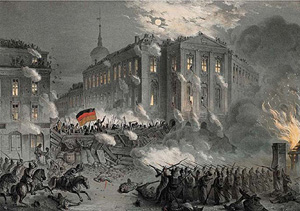1. A painting: Street Battle in the Rue Soufflot, painting by Horace Vernet, 1848 Lithograph: Street Battle by the Alexanderplatz in Berlin, 1848
Street Battle in the Rue Soufflot Paris 25.6.1848, a painting by Horace Vernet
 Click image to enlarge
Click image to enlarge
Street Battle by the Alexanderplatz in Berlin, a lithograph about 1848
 Click image to enlarge
Click image to enlarge
Questions
Geographical/Historical Context
In June 24, 1848, another upheaval among the working classes emerged in Paris, upon closing the French National Workshops, which had provided work opportunities to the unemployed. Yet, after fierce fights, the army and the National Guard soon quelled the June Days Uprising. In the end, 3,000 workers were dead. The June Days Uprising historically marks the separation of the revolutionary proletariat from the bourgeoisie, too.
Pressured by the revolutionary events in Berlin taking place since March 6, 1848, the Prussian King Frederick William IV first yielded. He agreed to call the Landtag, to adopt freedom of the Press, to abolish tariff barriers and to reform the German Confederation. After the reading of the respective legislation on March 18, two shots were fired by military rifles and dispersed thousands of people who had gathered on the Schlossplatz. As a result, barricade and street fights between the revolutionaries and the regular Prussian troops emerged in Berlin, whereby, for the time being, the insurgents were coming out on top. On March 19, the troops were withdrawn from Berlin by order of the King. The result of theses fights were several hundreds of dead and over a thousand injured people.
Links
http://www.ohio.edu/chastain/ac/blanc.htmAnswers
- Barricades, fires, insurgents, soldiers, banners, recognizable buildings of the respective capital.
- Soldiers fight against insurgents. In France, though, people in uniforms also fought on the part of the insurgents. The soldiers are better armed. In Berlin, a canon can be seen fighting with the insurgents.
- Both flags are in the middle of the picture, glowing (signal function); Germany: the flag symbolizes the unified German nation; Paris: the red flag symbolizes the working class, the socialists and the opposition to the existent form of government. The tricolour can be recognized on the other side of the barricades.




Presentation
On February 21, 1848, protests against the government started, first in Paris. In March, uprisings took place in the states of the German Confederation and the Habsburg Empire.